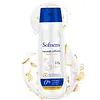What's inside
What's inside
 Key Ingredients
Key Ingredients

 Benefits
Benefits

 Concerns
Concerns

 Ingredients Side-by-side
Ingredients Side-by-side

Glycerin
HumectantAlcohol Denat.
AntimicrobialCetearyl Alcohol
EmollientCoco-Caprylate/Caprate
EmollientCocoglycerides
EmollientGlyceryl Stearate Se
EmulsifyingDicaprylyl Ether
EmollientColloidal Oatmeal
AbsorbentHydroxypropyl Starch Phosphate
Xanthan Gum
EmulsifyingCetyl Palmitate
EmollientGlyceryl Stearate
EmollientSodium Cetearyl Sulfate
CleansingTocopherol
AntioxidantCitric Acid
BufferingPhenoxyethanol
PreservativeCaprylyl Glycol
EmollientEthylhexylglycerin
Skin ConditioningParfum
MaskingGlycerin, Alcohol Denat., Cetearyl Alcohol, Coco-Caprylate/Caprate, Cocoglycerides, Glyceryl Stearate Se, Dicaprylyl Ether, Colloidal Oatmeal, Hydroxypropyl Starch Phosphate, Xanthan Gum, Cetyl Palmitate, Glyceryl Stearate, Sodium Cetearyl Sulfate, Tocopherol, Citric Acid, Phenoxyethanol, Caprylyl Glycol, Ethylhexylglycerin, Parfum
Water
Skin ConditioningCetearyl Alcohol
EmollientIsopropyl Myristate
EmollientCeteareth-22
EmulsifyingCaprylic/Capric Glycerides
EmollientTribehenin
EmollientGlycol Stearate
EmollientParaffinum Liquidum
EmollientXylitylglucoside
HumectantAnhydroxylitol
HumectantXylitol
HumectantCyclopentasiloxane
EmollientParfum
MaskingSodium Benzoate
MaskingPhenoxyethanol
PreservativeAminomethyl Propanol
BufferingDisodium EDTA
Avena Sativa Kernel Flour
AbrasiveMilk
Skin ConditioningCream
EmollientAcrylates Copolymer
Niacinamide
SmoothingCalcium Pantothenate
Sodium Ascorbyl Phosphate
AntioxidantTocopheryl Acetate
AntioxidantPyridoxine Hcl
Skin ConditioningMaltodextrin
AbsorbentSodium Starch Octenylsuccinate
AbsorbentSilica
AbrasiveWater, Cetearyl Alcohol, Isopropyl Myristate, Ceteareth-22, Caprylic/Capric Glycerides, Tribehenin, Glycol Stearate, Paraffinum Liquidum, Xylitylglucoside, Anhydroxylitol, Xylitol, Cyclopentasiloxane, Parfum, Sodium Benzoate, Phenoxyethanol, Aminomethyl Propanol, Disodium EDTA, Avena Sativa Kernel Flour, Milk, Cream, Acrylates Copolymer, Niacinamide, Calcium Pantothenate, Sodium Ascorbyl Phosphate, Tocopheryl Acetate, Pyridoxine Hcl, Maltodextrin, Sodium Starch Octenylsuccinate, Silica
Ingredients Explained
These ingredients are found in both products.
Ingredients higher up in an ingredient list are typically present in a larger amount.
Cetearyl alcohol is a mixture of two fatty alcohols: cetyl alcohol and stearyl alcohol. It is mainly used as an emulsifier. Emulsifiers help prevent the separation of oils and products. Due to its composition, it can also be used to thicken a product or help create foam.
Cetearyl alcohol is an emollient. Emollients help soothe and hydrate the skin by trapping moisture.
Studies show Cetearyl alcohol is non-toxic and non-irritating. The FDA allows products labeled "alcohol-free" to have fatty alcohols.
This ingredient is usually derived from plant oils such as palm, vegetable, or coconut oils. There is debate on whether this ingredient will cause acne.
Due to the fatty acid base, this ingredient may not be Malassezia folliculitis safe.
Learn more about Cetearyl AlcoholParfum is a catch-all term for an ingredient or more that is used to give a scent to products.
Also called "fragrance", this ingredient can be a blend of hundreds of chemicals or plant oils. This means every product with "fragrance" or "parfum" in the ingredients list is a different mixture.
For instance, Habanolide is a proprietary trade name for a specific aroma chemical. When used as a fragrance ingredient in cosmetics, most aroma chemicals fall under the broad labeling category of “FRAGRANCE” or “PARFUM” according to EU and US regulations.
The term 'parfum' or 'fragrance' is not regulated in many countries. In many cases, it is up to the brand to define this term.
For instance, many brands choose to label themselves as "fragrance-free" because they are not using synthetic fragrances. However, their products may still contain ingredients such as essential oils that are considered a fragrance by INCI standards.
One example is Calendula flower extract. Calendula is an essential oil that still imparts a scent or 'fragrance'.
Depending on the blend, the ingredients in the mixture can cause allergies and sensitivities on the skin. Some ingredients that are known EU allergens include linalool and citronellol.
Parfum can also be used to mask or cover an unpleasant scent.
The bottom line is: not all fragrances/parfum/ingredients are created equally. If you are worried about fragrances, we recommend taking a closer look at an ingredient. And of course, we always recommend speaking with a professional.
Learn more about ParfumPhenoxyethanol is a preservative that has germicide, antimicrobial, and aromatic properties. Studies show that phenoxyethanol can prevent microbial growth. By itself, it has a scent that is similar to that of a rose.
It's often used in formulations along with Caprylyl Glycol to preserve the shelf life of products.